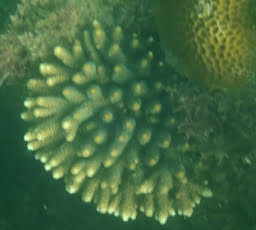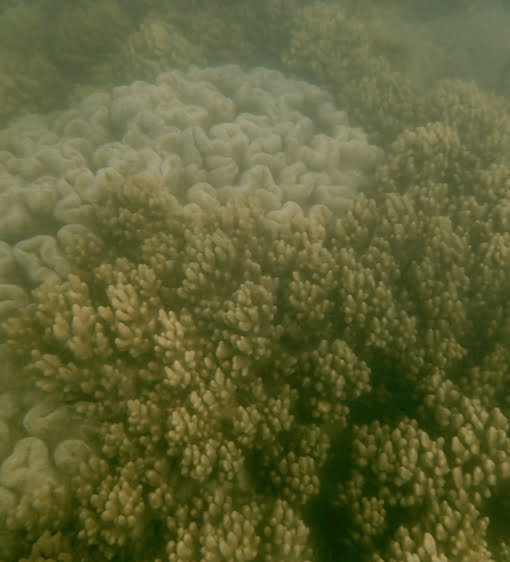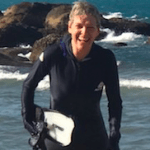MOST people rarely venture into nature – they certainly don’t spend much time on coral reefs. When they do, they may expect the fish and corals to be as bright, colourful and perfect as the last nature documentary that they saw in full surround-sound on a wide screen.
Such images come from professional photographers staying underwater for hours, perhaps after having waited days for very calm weather, so the water is exceptionally clear. Of course, such photographs are enhanced by bright lighting, so most of the footage would be taken on very sunny days. Also, a great expanse of shallow water – gives depth to the footage, and the further off-shore generally the clearer the water.

The Great Barrier Reef is vast. If you click onto the webpage at this link you will find zoning maps that give an idea of how long and how wide – in fact the area is visible from outer space.
Scroll down and click on Map 9, and you will find a map showing so many reefs off Bowen.
Bowen has made headlines for some years now – it is the place where Terry Hughes and other leading academics claim the reef is totally dead, and that this is representative of the whole inshore Great Barrier Reef. They are so wrong.
There is so much coral here off Bowen, and there are so many extensive areas of coral reef, and most are a very long way off shore – making the visit to just one of the outer reefs a long day trip by fishing boat.
Because cyclones and coral bleaching are a regular occurrence, the exact state of the corals at particular reef is not always predictable and in constant flux. This has been the case for thousands of years.
The Great Barrier Reef has existed for about 10,000 years: when sea levels rose at the beginning of the current geological epoch known as the Holocene. Because the reefs have been growing up-wards for thousands of years – while sea levels have fallen over one metre in the last 5,000 years – they are very vulnerable to bleaching, particularly when there is calm weather on a very low tide leaving corals high and dry for long periods.
Nevertheless, it is possible to find so much healthy coral, even at Bowen … at Horseshoe Bay, which is just around the corner from Queens Bay that is shown in the far-left corner of Map 9.
I’ve been in Bowen for several days now … waiting for the strong south-southeasterly winds to ease so we can take the boat out to visit some off-shore islands. The Skipper did take me out late yesterday (when we had a few hours of calm) to see the coral the other side of Bramston reef – I’m meaning beyond the mud flat and reef flat that I walked last Friday on the very low tide.
It is so wrong for Terry Hughes to suggest that this reef has all been reduced to mud flat. That the coral off Bowen is all dead.
There is live coral, and lots of it, at depth at Bramston reef. I got lots of photographs from my cheap camera and just snorkelling (no tank) and I might post more in due course.

My preference would be to get a professional underwater photographer to take better photographs and as a movie so you can see the full extent of this ancient reef.
Late yesterday some of Bramston reef looked so eerie – then again it is about 4,500 years old.
Someone needs to go down with a good camera and a tank of oxygen and get extensive footage that shows the great diversity, and all the fish – there might even be a crocodile hiding somewhere.
Parts of Bramston reef have been reduced to rubble, some from Cyclone Debbie that hovered over Bowen just two years ago. But there is also new coral, and extensive areas of healthy and live corals at this ancient reef.

I’m hoping to see another ancient reef off Bowen this afternoon … perhaps the Skipper and Matt will take me to Middle Island.
In the meantime, subscribe at my blog, so you are sure to be one of the first to find out when, and if, I can find a professional underwater photographer to show you ancient Bramston reef, including the crocodile.
If you are impatient and overseas, just jump on a plane and then bus or train it to Bowen. Nicole Kidman has even been here, but she thought Bowen was Darwin. Don’t believe Hollywood, the academics or doomsayers (the Elites can be so lame) – there is so much more than mudflats and cowboys at Bowen.

*****
The feature image is of me, and very happy, because I had just been snorkeling at Horseshoe Bay (Bowen) – and there are so many pretty corals, and I saw a sting ray. 


 Jennifer Marohasy BSc PhD is a critical thinker with expertise in the scientific method.
Jennifer Marohasy BSc PhD is a critical thinker with expertise in the scientific method.

Atta girl Dr Jen, My 16 year old son Jono and I were so glad to be part of supporting your BOWEN coral reef trip the last few days. Let’s hope today gives further evidence to support you and Professor Ridd’s exposee👏👏🤔
Keep it up, you lucky little bugger, so far from any sea here.
HOORAY FOR JENNIFER MARAHASY & PETER RIDD!!!! &, on a peanut budget too, compared to the billions going to the “reef is dying” squad. Dr M’s video footage is v. similar to what I see snorkelling around my far north Queensland home – with the exception that except for small pieces of of coral washed up on mudflats, I haven’t seen dead coral patches in deep water. Of course, there are billions of reasons for the “reef is dying” paid hierarchy to hide their fraud. What a life these paid reef staff experience – huge money to do what tourists pay upwards of $200 for just a few hours & with professional photographers. Maybe a fundraiser to get a professional to take video for Dr M? I’ll make a donation. &, here’s another thought, there was a big court case in the UK following the media scare campaign for the J curve global warming research fraud. After the court case, Al Gore’s alleged documentary could only be shown in UK schools with warnings that it was not a documentary as it alleged but propaganda based on misinformation & exaggeration. Australia is due for something like this after Green agent provocateurs stampeded mobs of frightened schoolchildren into hitting the streets waving placards. These children will become adults with the deluded fear that we are doomed if we don’t bankrupt the nation by abandoning fossil fuels. Just like other fraud, research fraud needs to be heavily criminalised to stop its insidious effect – spreading mass hysteria disguised as science, the research fraud is against Australians’ best interests.
While you are in the area Jennifer. It might be good to have a look at some other areas. Groper Creek is one. & the Northern side of Cape Upstart where the Japanese Submarines would come in to Water. There used to be thousands of Japanese Whisky Bottles scattered along the Beaches when I was a kid in the 50/60. Good Reefs there.
Upstart Bay is quite shallow because the Burdekin empties great amounts of silt into it. It’s also the first place that Giant Manta Rays were observed Mating by my Brother. However, AIMS threw him off their Jetty & told him that no-one knows where the breed. That is until a year later, when a Professor from AIMS “discovered” this amazing event in Upstart Bay.
The Southern Side of Cape Upstart. The water is deep just off the Coast with some good reefs. At the Bottom end of Cape Upstart is Camp Island. There used to be horses on the Island for about 60 years. They came from a Wreck. There is no fresh water on that Island yet they survived. They were taken off the Island in the 70’s.
Talk to some of the old timers around the area.
It is so easy for these people to cheat when reporting the Great Barrier reef.
At Hardy reef off the Whitsundays, where I installed the Telford reef instillation, you can chose great coral or mostly dead coral with in 60 metres of each other. The coral on the western side of Hardy, in the channel between Hardy & Hook reefs is good, & some really great. Just 60 metres across the ribbon of drying coral that encloses the 7500 acre lagoon, you will find all the dead coral you could ever want to photograph.
Fresh water is toxic to coral. In the wet season the high rainfall actually reduces the salinity of the lagoon water enough, & for long enough to inhibit new coral growth, & kill much which has survived. You will find the same effect in many lagoons, & in many fringing reefs.
When I was sailing the waters of New Guinea & the Solomons in the 70s, much of the coastlines were shown by a dotted line. They had yet to be surveyed & charted. When I needed to get in behind the fringing reef somewhere, I would look for one of the many little rivers draining the high mountains. I knew I would find a navigable channel through the reef very near the mouth of such rivers. The fresh water kept these areas reasonably free of coral.
It really is an indictment of our academic community that they are prepared to play such games to promote their grants.
It’s my understanding that much “surveying” of reef and coastal coral is done from the air. Just how much does that “at-a-distance” observation skew the results, I wonder. Judging by this an your last post, I’d say quite a bit.
I posted a tweet a while back, asking the (rhetorical) question:
If a marine biologist could spend a lifetime studying just one of the many hundreds (thousands?) of reefs that make up the GBR, and still have much to learn, how is it that the “experts” seem to know the past, present and future condition of the whole system, north to south, east to west?
Love your work Jennifer. I hope people like Peter Ridd, yourself and Joanna Nova can keep up your excellent work in exposing the exaggeration currently being put forward by Universities, apparently to secure funding. This is a tragedy for science.
Nice one. Lets have more images when you can manage it.
Going snorkeling and snapping some photos. Looks like quality research…..
I think you should crowdsource a doco Jenn. I’d put in some money (a little). Or run a competition for the best shots of the best coral. Or collate an annotated Google map of the reef with anecdotes like the ones above hyperlinked onto it, as well as photos.
Wait, you mean that the climate catastrophists might be misrepresenting the facts?
Looks like a lively time.
Thank you for an excellent update.
Prof Terry Hughes has NEVER said that the whole Reef is dead. What he maintains is the the Reef is dying because of coral bleaching and acidification of the oceans, due to clinate fhange. Thereare other factors which are undermining the health of the Reef incoyding crown of thorns star fish and sediment runoff but climate change will kill the Reef as we once knew it. So again, lies from climate change deniers. Dr Peter Ridd won his case against JCU which was nothing to do with his views on the Reef. Rather, it was a rejection of JCU’s processes in sacking him, which is why academics who vehemently oppose Ridd’s views on the Reef, supported his case.
****
Hi Jenny
Terry Hughes spoke at a conference in Cairns not so many years ago … and he actually said that the coral off Bowen was dead. It was on the front page of the Cairns Post newspaper. He showed a picture of the mud flat, and said that the coral was all covered in mud. It was most misleading. See my previous post for more information:https://jennifermarohasy.com/2019/04/denying-the-littoral-zone-at-the-great-barrier-reef/
His misleading claims were subsequently widely reported, and the Bowen tourism industry has suffered accordingly. An apology is really in order.
Also, I’d be happy to take both you and Terry to see the coral reefs at, and off, Bowen.
Cheers, Jennifer
PS I’ve never meet a sceptic, who denied that the climate changes. :-).
as an engineer-diver I am always amazed at the amount of marine life, fish and corals growing on docks and quaywalls, yet the “expert” environmental bureaucrats will fight you on getting dock permits saying man made structures damage the environment. In Pearl Harbor Hawaii, the coral growth on the Navy dock pilings is so heavy that the piles have grown together just below low water, despite the continuing oil leakage, turbidity and urban runoff. It really does show the resilience of corals. I think it has much more to do with finding hard substrate to grow on, resistant to wave movement.